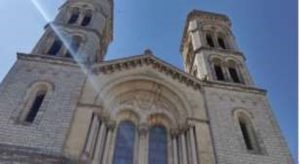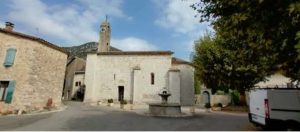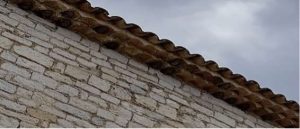Declining passage of House Martins
The passage of House Martins (HM) seems to have tailed off dramatically in this part of the Cévennes mountains (St Martial, 30440, Gard). This is not too far from the Department of Herault (34) which borders the Mediterranean.
In previous years exhausted HMs arrived between 14-26 August, but none at all this year. The following quote is from an article published in 2017. There were of course a few groups of HMs passing through in the late evening during August, foraging low, but not every evening, perhaps twice a week. Other birds were also diminished in numbers such as Bee-eaters, which in previous years were a daily occurrence high up and out of sight calling melodiously, now restricted to two or three days in August. HMs were seen in market towns Ganges (34) massing on the church 11th August (perhaps 80 birds), and in Le Vigan (30) also on the church on 22nd August (perhaps 45 birds), both on one of the highest points of these market towns.

[1] Feltwell, J. 2017. Bio-indicators of climate and habitat change in the Basses=Cevennes, France over 50 years. Br. J. Ent. Nat. Hist., 30:2017.
 HMs gathering on the church clock in Le Vigan – some on the vertical walls, some fanning their tail feathers to cool. Temperature at 1045hr was about 36°C.
HMs gathering on the church clock in Le Vigan – some on the vertical walls, some fanning their tail feathers to cool. Temperature at 1045hr was about 36°C.

HMs gathering above the church in Ganges (34).
House Martins in La Cadière village (Gard, 30)House Martins in La Cadière village (Gard, 30)
My chosen village for HM study was the small community of La Cadière (Gard, 30170) which has a village church aligned east-west and the south face is always occupied with HMs. I had come across it by chance and it had lots of HMs.
The small community is set around a small stream which issues from a mountain pass to the north, which flows into the fields now occupied by vineyards. The presence of water not only is responsible for the civilisation that has grown up there, but the HMs finding a ready supply of mud for nest building.
The protestant church (actually a priory) burned by the Camisards in the early 18th century and is now covered with Romanesque tiles, much favoured by house martins. The overlapping layers of these tiles – sometimes three layers on the edges – (also called Provencal tiles) providing an overhang, shade and purpose built areas to build a nest are typical of the whole region of Gard and Herault.
[1] Correctly Saint-Michel de La Cadière-et-Cambo


The 14th century priory of La Cadière – with most nests along this south elevation.

The three layers of overlapping tiles provide good habitat for HM nest construction

Aspect is everything
The church had 58 HM nests facing South, none on the East, and only 4 on the West, even though there was similar opportunity in terms of tiles and niches for the birds. Collectively with the five other buildings around the centre of the village that supported nests (the overall total being 117) more nests were facing South (61), North (27), West (14) and East (5).
This has implications for the positioning of HM nests, where, in this area in southern France at least the birds choose to nest most facing south, then north and fewer on the west and east.
One wonders why south is such a good direction considering this is the south of France and the summer temperatures are regularly in the 30°C in July and August. Perhaps the shade of the overlapping tiles is the key.
A check of HMs in Ganges (34) revealed that of a total of 185 nests along four roads in the centre of the town more were facing East (85) followed closely by South (75), West (17) and North (8). This presents different aspects for nesting than La Cadiere.
Two factors may account for this, where the houses along a narrow street almost meet three storeys up, in a street going east-west there may be nests on both sides, thus north and south, with similar splitting of nests east and west for streets running north-south. The peaceful and sheltered space between the buildings may provide sufficient cover and convenience for nest buildings, where direction is not a big issue. Also, for small squares with buildings on all sides, the weather exposure from the east is always limited, making for an easterly aspect just as agreeable as the southern one. The warming sun from the east is beneficial if it is sheltered.
In this area first arrivals of HMs can be, unusually, late February. I visited the site in late March and found no HM arrivals. My next visit was in early August and the birds were into their second brood, and every single bird was gone by 1 September.
Unknown to me until I did some internet research, was the fact that a fellow naturalist had been doing a lot of HM field research to the east of La Cadiere.
Patrice Cramm has been checking on HMs in 13 villages in the Vidourle valley form Quissac to the sea. His conclusions from 1982 to 2021 are that the number of completed nests suffered a decrease of 27.6%. It is worth looking at this website as it is full of year by year data and graphs, and discussions on variable results which in the long term fluctuate unpredictably.
These results are perhaps better (i.e. less decline) than the 41% decrease published by the Muséum National d’Histoire Naturelle (MNHN) following a survey in 2010. Some important dates for the 13 villages:
• 1982: 1535 complete nests (1st count)
• 1990: 1677 complete nests, record number of complete nests counted over the period 1982-2021
• 2015: 880 complete nests, lowest in the follow-up period
• 2021: 1111 complete nests last count
th
In Quissac 29 Feb.
[1] Quissac, Brouzet-lès-Quissac, Carnas and Sommières which are in the Gard and 9 other villages which are in the Hérault.
[1] Le C O Gard (Centre Ornithologique du Gard) https://cogard.org/hirondelles/
[1] In French HM are called ‘HIrondelles des fenêtres’ or Window Swallows, but they are definitely Chelidon urbica. HM and Swallows are often lumped together as ‘HIrondelles’ or swallows.
Boards to collect droppings
There is a continuing issue of how far away to erect boards to collect droppings, so as not to interfere with the comings and goings of nesting birds, and to save poo splat on pavements and people. The issue is not as bad as for swifts which need at least 2m for them to drop and get airborne.
In UK the RSPB recommend placing a board (250mm wide) about two metres below the nest for HMs.(7)
In France the LPO (League for the Protection of Birds) show an artificial HM nest box with an integral base 200mm below.(8)
A French supplier of artificial nest (Oisillon.net) shows a proprietary nest with a board about 700mm below.(9)
Nest boxes are being erected in France, at least in Herault with boards attached, i.e. close.

New HM nests with close board (left) A droppings board erected below nests in tiles (right)
[1] RSPB, 2023 What to do about nesting house martins https://www.rspb.org.uk/birds–andwildlife/advice/wildlife–and–the–law/birds–in–the–roof/What–to–do–about–nesting–house–martins/ (accessed 12 Sept 2023).
[1] LPO ‘Agir pour la biodiversite’ The Window Swallow has a photo of 4 in the nest… https://www.lpo–idf.fr/index.php?pg=sp&sp=33 and ANC with board base 200mm
[1] https://www.oisillon.net/content/35–les–hirondelles–especes–protegees–ca–veut–dire–quoi–

Integral board above window, and a special board above a door (left) Boards above windows (ca. 1.5m) (right)
Shell (yes Shell) HM nests
It was a pleasant surprise to pull into a service station ca65km south of Rheims on the A26 autoroute at Sommesous, the ‘Aire des oiseaux migrateurs’, and find the filling pump area was fitted out with House Martin nests – ten double nests! Full marks to Shell! None were occupied at the time (6 Sept) and there was no evidence of poo on the ground – because unwitting motorists filling up would have carried it all away! Nice one.
The service station (or ‘Aire’) is on a relatively high ground and on a migratory route, so our UK HMs may well fly over this site on the way to the large man-made lake some distance of to the south-east called ‘Der-Chantecoq lake, created in 1974 in the Champagne region. It is an ornithological hot-spot and 310 bird species have been recorded there with the annual passage of birds over the area of 450,000 individuals. So when filling-up do look out for HMs here.


Further Reading
La Zebrine. Association d valorisation du patrimoine rural. 2019. An illustrated lecture by Christian Hubert, on the ‘hirondelles’ of Gard.
https://www.zebrine.org/la-migration-deshirondelles-du-gard/.
Worth checking out as it shows migratory routes of HMs and swallows etc. As he says only the HM remains a big mystery as to where it goes to in winter.
Legal protection in France. See. https://www.oisillon.net/content/35-les-hirondellesespeces-protegees-ca-veut-dire-quoi- Includes an article from LPO which is the League for the Protection of Birds.
Citizen science: (from a website translated in English) the law includes HMs.
If you notice the destruction of swallow or swift nests, we invite you as a citizen to alert the French Office for Biodiversity (37) (02.47.26.80.13 – sd37@ofb.gouv.fr) which is a structure empowered to detect infringements in many areas related to nature protection.
Written by John Feltwell
13 Sept 2023

